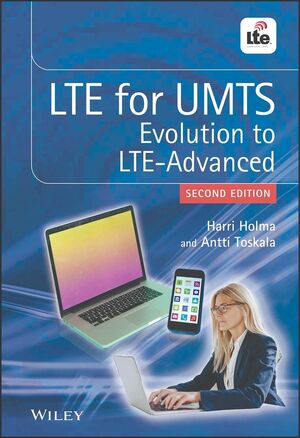LTE for UMTS: Evolution to LTE-Advanced, 2nd EditionISBN: 978-0-470-66000-3
Hardcover
576 pages
April 2011
 |
||||||
Acknowledgements.
List of abbreviations.
1 Introduction (Harry Holma and Antti Toskala).
1.1 Mobile Voice Subscriber Growth.
1.2 Mobile Data Usage Growth.
1.3 Evolution of Wireline Technologies.
1.4 Motivation and Targets for LTE.
1.5 Overview of LTE.
1.6 3GPP Family of Technologies.
1.7 Wireless Spectrum.
1.8 New Spectrum Identified by WRC-07.
1.9 LTE-Advanced.
2 LTE Standardization (Antti Toskala).
2.1 Introduction.
2.2 Overview of 3GPP Releases and Process.
2.3 LTE Targets.
2.4 LTE Standardization Phases.
2.5 Evolution Beyond Release 8.
2.6 LTE-Advanced for IMT-Advanced.
2.7 LTE Specifications and 3GPP Structure
3 System Architecture Based on 3GPP SAE 23 (Atte Länsisalmi and Antti Toskala).
3.1 System Architecture Evolution in 3GPP.
3.2 Basic System Architecture Configuration with only E-UTRAN Access Network.
3.3 System Architecture with E-UTRAN and Legacy 3GPP Access Networks.
3.4 System Architecture with E-UTRAN and Non-3GPP Access Networks.
3.5 Inter-working with cdma2000® Access Networks.
3.6 IMS Architecture.
3.7 PCC and QoS.
References.
4 Introduction to OFDMA and SC-FDMA and to MIMO in LTE (Antti Toskala and Timo Lunttila).
4.1 Introduction.
4.2 LTE Multiple Access Background.
4.3 OFDMA Basics.
4.4 SC-FDMA Basics.
4.5 MIMO Basics.
4.6 Summary.
References.
5 Physical Layer (Antti Toskala, Timo Lunttila, Esa Tiirola, Kari Hooli, Mieszko Chmiel and Juha Korhonen).
5.1 Introduction.
5.2 Transport Channels and their Mapping to the Physical Channels.
5.3 Modulation.
5.4 Uplink User Data Transmission.
5.5 Downlink User Data Transmission.
5.6 Uplink Physical Layer Signaling Transmission.
5.7 PRACH Structure.
5.8 Downlink Physical Layer Signaling Transmission.
5.9 Physical Layer Procedures.
5.10 UE Capability Classes and Supported Features.
5.11 Physical Layer Measurements.
5.12 Physical Layer Parameter Configuration.
5.13 Summary.
References.
6 LTE Radio Protocols (Antti Toskala, Woonhee Hwang and Colin Willcock).
6.1 Introduction.
6.2 Protocol Architecture.
6.3 The Medium Access Control.
6.4 The Radio Link Control Layer.
6.5 Packet Data Convergence Protocol.
6.6 Radio Resource Control (RRC).
6.7 X2 Interface Protocols.
6.8 Understanding the RRC ASN.1 Protocol Definition.
6.9 Early UE handling in LTE.
6.10 Summary.
References.
7 Mobility (Chris Callender, Harri Holma, Jarkko Koskela and Jussi Reunanen).
7.1 Introduction.
7.2 Mobility Management in Idle State.
7.3 Intra-LTE Handovers.
7.4 Inter-system Handovers.
7.5 Differences in E-UTRAN and UTRAN Mobility.
7.6 Summary.
References.
8 Radio Resource Management (Harri Holma, Troels Kolding, Daniela Laselva, Klaus Pedersen, Claudio Rosa and Ingo Viering).
8.1 Introduction.
8.2 Overview of RRM Algorithms.
8.3 Admission Control and QoS Parameters.
8.4 Downlink Dynamic Scheduling and Link Adaptation.
8.5 Uplink Dynamic Scheduling and Link Adaptation.
8.6 Interference Management and Power Settings.
8.7 Discontinuous Transmission and Reception (DTX/DRX).
8.8 RRC Connection Maintenance.
8.9 Summary.
References.
9 Self Organizing Networks (SON) (Krzysztof Kordybach, Seppo Hamalainen, Cinzia Sartori and Ingo Viering).
9.1 Introduction.
9.2 SON Architecture.
9.3 SON Functions.
9.4 Self-configuration.
9.5 Self-Optimization and Self-Healing Use Cases.
9.6 3GPP Release 10 Use Cases.
9.7 Summary.
References.
10 Performance (Harri Holma, Pasi Kinnunen, István Z. Kovács, Kari Pajukoski, Klaus Pedersen and Jussi Reunanen).
10.1 Introduction.
10.2 Layer 1 Peak Bit Rates.
10.3 Terminal Categories.
10.4 Link Level Performance.
10.5 Link Budgets.
10.6 Spectral Efficiency.
10.7 Latency.
10.8 LTE Refarming to GSM Spectrum.
10.9 Dimensioning.
10.10 Capacity Management Examples from HSPA Networks.
10.11 Summary.
References.
11 LTE Measurements (Marilynn P. Wylie-Green, Harri Holma, Jussi Reunanen and Antti Toskala).
11.1 Introduction.
11.2 Theoretical Peak Data Rates.
11.3 Laboratory Measurements.
11.4 Field Measurement Setups.
11.5 Artificial Load Generation.
11.6 Peak Data Rates in the Field.
11.7 Link Adaptation and MIMO Utilization.
11.8 Handover Performance.
11.9 Data Rates in Drive Tests.
11.10 Multi-User Packet Scheduling.
11.11 Latency.
11.12 Very Large Cell Size.
11.13 Summary.
References.
12 Transport (Torsten Musiol).
12.1 Introduction.
12.2 Protocol Stacks and Interfaces.
12.3 Transport Aspects of Intra-LTE Handover.
12.4 Transport Performance Requirements.
12.5 Transport Network Architecture for LTE.
12.6 Quality of Service.
12.7 Transport Security.
12.8 Synchronization from Transport Network.
12.9 Base Station Co-location.
12.10 Summary.
References.
13 Voice over IP (VoIP) (Harri Holma, Juha Kallio, Markku Kuusela, Petteri Lundén, Esa Malkamäki,Jussi Ojala and Haiming Wang).
13.1 Introduction.
13.2 VoIP Codecs.
13.3 VoIP Requirements.
13.4 Delay Budget.
13.5 Scheduling and Control Channels.
13.6 LTE Voice Capacity.
13.7 Voice Capacity Evolution.
13.8 Uplink Coverage.
13.9 Circuit Switched Fallback for LTE.
13.10 Single Radio Voice Call Continuity (SR-VCC).
13.11 Summary.
References.
14 Performance Requirements (Andrea Ancora, Iwajlo Angelow, Dominique Brunel, Chris Callender, Harri Holma, Peter Muszynski, Earl McCune and Laurent Noël).
14.1 Introduction.
14.2 Frequency Bands and Channel Arrangements.
14.3 eNode-B RF Transmitter.
14.4 eNodeB RF Receiver.
14.5 eNodeB Demodulation Performance.
14.6 User Equipment Design Principles and Challenges.
14.7 UE RF Transmitter.
14.8 UE RF Receiver Requirements.
14.9 UE Demodulation Performance.
14.10 Requirements for Radio Resource Management.
14.11 Summary.
References.
15 LTE TDD Mode (Che Xiangguang, Troels Kolding , Peter Skov, Wang Haiming and Antti Toskala).
15.1 Introduction.
15.2 LTE TDD Fundamentals.
15.3 TDD Control Design.
15.4 Semi-persistent Scheduling.
15.5 MIMO and Dedicated Reference Signals.
15.6 LTE TDD Performance.
15.7 Evolution of LTE TDD.
15.8 LTE TDD Summary.
References.
16 LTE-Advanced (Mieszko Chmiel, Mihai Enescu, Harri Holma, Tommi Koivisto, Jari Lindholm, Timo Lunttila, Klaus Pedersen, Peter Skov, Timo Roman, Antti Toskala and Yuyu Yan).
16.1 Introduction.
16.2 LTE-Advanced and IMT-Advanced.
16.3 Requirements.
16.4 3GPP LTE-Advanced Study Phase.
16.5 Carrier Aggregation.
16.6 Downlink Multi-antenna Enhancements.
16.7 Uplink Multi-Antenna Techniques.
16.8 Heterogeneous Networks.
16.9 Relays.
16.10 Release 11 Outlook.
16.11 Conclusions.
References.
17 HSPA Evolution (Harri Holma, Karri Ranta-aho and Antti Toskala).
17.1 Introduction.
17.2 Discontinuous Transmission and Reception (DTX/DRX).
17.3 Circuit Switched Voice on HSPA.
17.4 Enhanced FACH and RACH.
17.5 Downlink MIMO and 64QAM.
17.6 Dual Cell HSDPA and HSUPA.
17.7 Multicarrier and Multiband HSDPA.
17.8 Uplink 16QAM.
17.9 Terminal Categories.
17.10 Layer 2 Optimization.
17.11 Single Frequency Network (SFN) MBMS.
17.12 Architecture Evolution.
17.13 Summary.
References.
Index.



